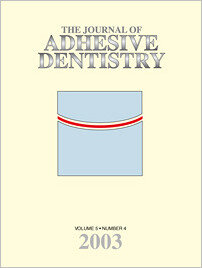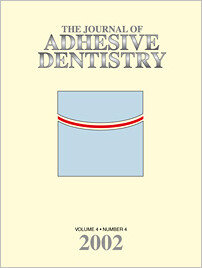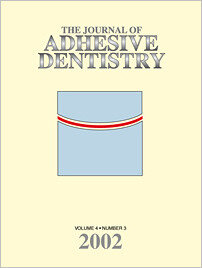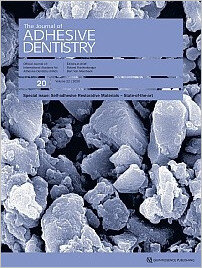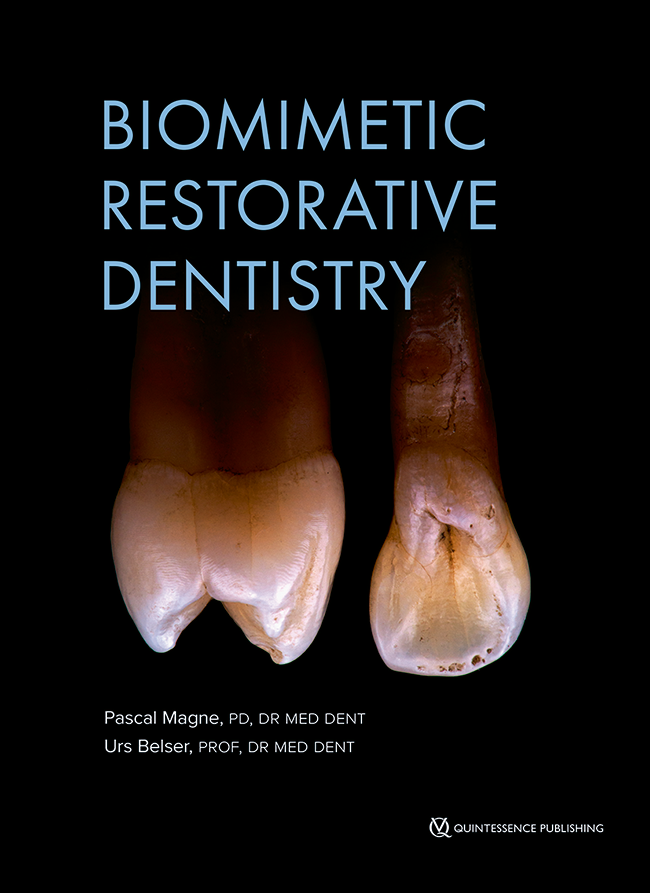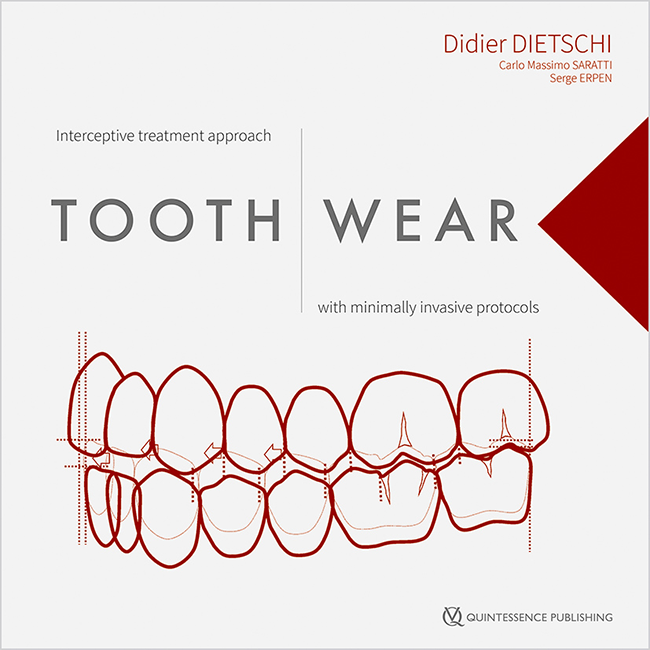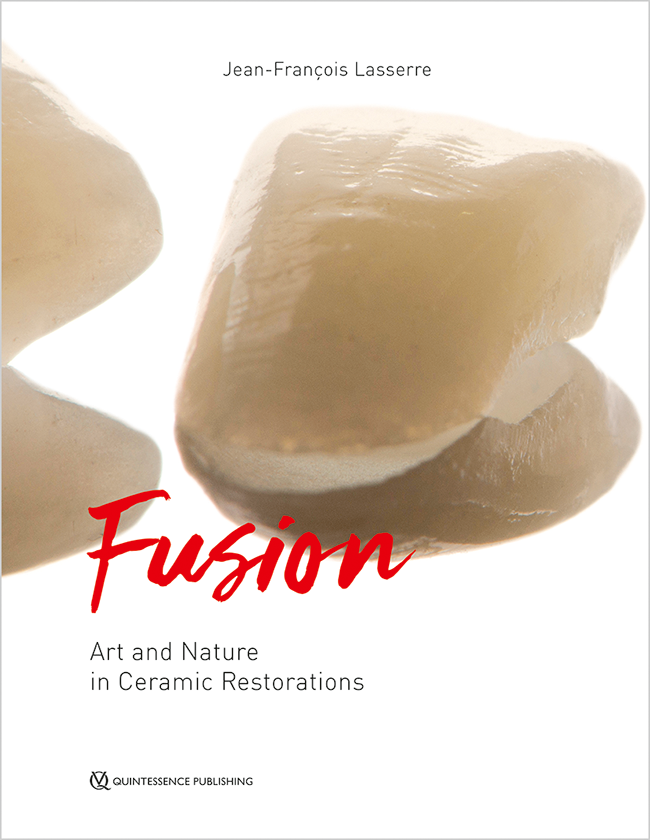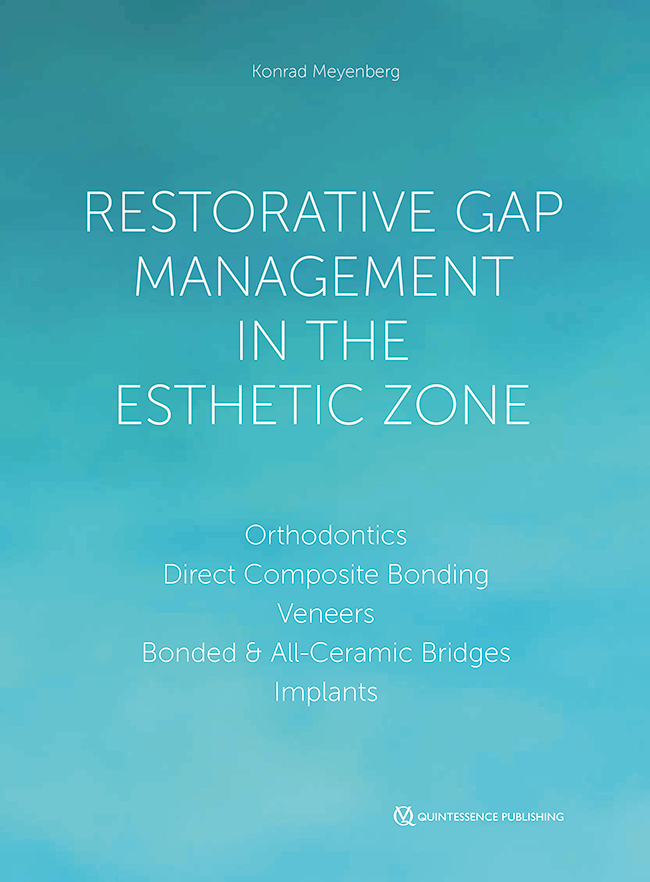DOI: 10.3290/j.jad.a8752Páginas 255, Idioma: InglésRoulet, Jean-FrançoisDOI: 10.3290/j.jad.a8753Páginas 259-266, Idioma: InglésTyas, Martin J.The glass-ionomer cements (GIC), when introduced in the 1970s, were initially welcomed as the first chemically-adhesive esthetic restorative materials. However, the clinical results were disappointing, as these early products were brittle and were particularly susceptible to early water loss and uptake, and to long-term water loss. Continued development, notably the addition of resin polymerization components, has made the GIC an increasingly important part of clinical practice.
DOI: 10.3290/j.jad.a8754Páginas 267-282, Idioma: InglésSuh, B. I. / Feng, L. / Pashley, D. H. / Tay, Franklin RusselThis study examined the polymerization kinetics of acid-contaminated light- and chemically-cured resins with the use of differential scanning calorimetry.
Light-cured and chemically-cured versions of an experimental bis-GMA/TEG- DMA resin at the ratio (w:w) of 62:38 were prepared. Four acidic resin monomers with either carboxylic (DSDM and MAA) or phosphoric functional groups (MP and 2MP) were added at a 10 wt% concentration to these resins to simulate the intermixing of resin composites and unpolymerized acidic monomers along the adhesive-composite interface of simplified-step dentin adhesives. Different concentrations of the most acidic monomer 2MP (10 to 50 wt% for the light-cured resin, and 2 to 4 wt% for the chemically-cured resin) were also added to examine their contribution to reducing the extent and rate of polymerization of these resin mixtures. The effect of sodium benzene sulphinate on the polymerization of the chemically-cured resin that was contaminated with 10 wt% 2MP was also investigated.
At 10 wt% concentration, all acidic monomers had a limited effect on the polymerization of the light-cured resin. The rate and extent of polymerization in the chemically-cured resin was substantially reduced by the carboxylic acid monomers DSDM and MAA, while polymerization was completely inhibited in the presence of the organophosphate monomers MP and 2MP. Substantial reductions in the rate and extent of polymerization of the light-cured resin occurred only in the presence of high concentrations (30 to 50 wt%) of 2MP. More acute polymerization inhibition was observed when the chemically-cured resin was contaminated with 2 to 3 wt% 2MP, with polymerization completely inhibited at 4 wt%. Addition of sodium benzene sulphinate to 2MP-contaminated chemically-cured resin revived the previously uncured resins, but their rate and extent of polymerization were still inferior to that of uncontaminated chemically-cured resin.
When the influence of adhesive permeability was excluded with the use of neat, water-free resins, deactivation of the tertiary amine utilized in the chemically-cured resin by even very low concentrations of acidic resin monomers accounts for the reported incompatibility between simplified-step dentin adhesives and chemically-cured composites. The polymerization of light-cured resin is only affected by much higher concentrations of acidic resin monomers.
DOI: 10.3290/j.jad.a8755Páginas 283-291, Idioma: InglésFelix, C. A./Price, R. B. T.To investigate how light intensity changes as the distance increases from the tip of the light guide.
Ten different curing light/light guide combinations were used. Light intensity was measured at 0, 3, 6, and 10 mm from the tip of the light guide with a radiometer. Measurements were repeated in five separate trials and the mean light intensity ± standard deviation was calculated. The fiber density was measured at the entrance and exit of all ten light guides and the light dispersion patterns were recorded.
Light intensity decreased as distance increased for all lights tested; however, the rate and extent of this decrease was not similar for all lights (p 0.0001). Turbo light guides exhibited a more rapid decrease in intensity as the distance increased than standard light guides. At 10 mm, all the turbo light guides had lost over 80% of their intensity recorded at 0 mm.
1. The rate and extent of the decrease in intensity is not similar among curing lights (p 0.0001). 2. It is not possible to predict light intensity at 10 mm from measurements made at 0 mm. 3. Curing light manufacturers should state intensity over clinically relevant distances (0 to 10 mm).
DOI: 10.3290/j.jad.a8756Páginas 293-300, Idioma: InglésNikaido, T./Nakaoki, Y./Ogata, M./Foxton, R./Tagami, J.An experimental single-step bonding system, RZ-II, has been developed as a resin coating material for crown preparation. The purpose of this study was to compare the dentin microtensile bond strengths (MTBSs) of RZ-II in direct and indirect use.
Human molar dentin was used. The specimens were divided into three groups of n = 20 each. Group 1: RZ-II was applied to the dentin surface once or twice, and built up with a direct composite. Group 2: The dentin surface was provisionally covered and stored in water for 1 day. The provisional material was removed and an indirect composite was then bonded to the dentin surface. Group 3: RZ-II was applied to the dentin surface once or twice for "resin coating" before the placement and removal of provisional material. An indirect composite was then bonded to the coated dentin. After 1 day, MTBSs were measured at a crosshead speed of 1 mm/min. The data were analyzed using one-way ANOVA and Fisher's PLSD test (p 0.05). The interface between the indirect composite and resin-coated dentin was also observed using a SEM.
The MTBSs of RZ-II in Groups 1 and 3 were significantly higher than those of Group 2 (p 0.05). The thickness of the resin-coating layer and the hybrid layer were 5 to 6 µm and less than 1 µm, respectively.
The single-step bonding system, RZ-II, could be useful as a resin coating material for crown preparation.
DOI: 10.3290/j.jad.a8757Páginas 301-311, Idioma: InglésTezvergil, A. / Lassila, L. V. J. / Vallittu, Pekka K.To compare in vitro the bond strength of a particulate filler composite and two brands of fiber-reinforced composite (FRC) to teeth with or without the addition of flowable composite at the adhesive interphase. Physicomechanical properties that might contribute to the bonding were also evaluated.
Two hundred extracted human molars were used as substrates with a standard acid-etch and adhesive technique. FRC material [everStick (EV) or Stick (SC)] was applied on the substrate either directly or with a thin layer of flowable composite resin [Tetric Flow (TF)] and light cured for 40 s. As a control, particulate filler composite was used. The specimens (n = 10) were water stored for 24 h or thermocycled for 6000 cycles and subjected to shear bond strength testing. Fracture surfaces were analyzed with SEM and the microhardness and thermal expansion behavior of the materials at the adhesive interface were also evaluated. Multifactorial ANOVA and Tukey's post hoc tests were used at a significance level of p 0.05.
ANOVA showed that storage condition and substrate type (p 0.05) had a significant effect on the bond strength values. Bond strengths of FRC did not show a significant difference compared to the control (p > 0.05). For enamel, the mean bond strengths in MPa (SD) after thermocycling were: control 19.4 (3.8); EV 22.3 (3.6); SC 16.9 (4.9); EV-TF 22.8 (3.2); SC-TF 16.7 (2.7); and for dentin they were: control 15.3 (5.57); EV10.2 (2.2); SC 14.4 (4.5); EV-TF 8.85 (1.1); SC-TF 15.6 (3.6). Thermocycling increased the bond strength values typically by 10 %. The presence of flow composite resin did not produce any significant effect (p > 0.05).
The bond strength of FRC did not differ from that of particulate filler composite, and the addition of flowable composite did not improve bond strength values.
DOI: 10.3290/j.jad.a8758Páginas 313-321, Idioma: InglésCourson, F./Renda, A.-M./Attal, J.-P./Bouter, D./Ruse, D./Degrange, M.To compare the penetration and the imperviousness of two pit and fissure sealants according to surface treatments involving different cleaning procedures with or without subsequent acid etching.
Two sealants were used: a resin-based sealant (Concise White Sealant) and a compomer-based material (Dyract Seal) coupled with an enamel-dentin bonding agent (Dyract Seal and Prime&Bond NT). Extracted molars (n = 120) were randomly divided into 12 groups: 4 control and 8 experimental groups that received different surface treatments. Pumice, alumina, or bicarbonate was used to clean the surfaces. Phosphoric acid or non-rinse conditioner was used as acid etching agents. After sealing, the Concise White Sealant groups were directly thermocycled for 1800 cycles, while the Dyract Seal groups were stored in water for one month before thermocycling. After apex sealing and varnish coating, the fillings were stained with silver nitrate and embedded. Three to 6 cross sections of 200 µm each were made per sample to assess both sealant penetration (% of the length of the fissure) and the imperviousness of the seal (scores method).
Concise White Sealant achieves a better enamel sealing than Dyract Seal when the teeth are treated with air abrasion or air polishing followed by etching. Acid etching is essential for good sealing, whatever the material and cleaning technique tested. Only the combination of air abrasion and phosphoric acid etching yielded a leak-free joint.
This study clearly shows that penetration and sealing are two different phenomena. Ideally, an efficient sealant must have a good sealing ability and a high rate of infiltration as well, but these two properties probably do not have the same clinical relevance. The imperviousness of the seal remains the most important requirement.
DOI: 10.3290/j.jad.a8759Páginas 323-332, Idioma: InglésLoguercio, A. D. / Reis, A. / Barbosa, A. N. / Roulet, Jean-FrançoisThe aim of this double-blind randomized study was to compare the clinical performance of a resin-modified glass ionomer (Vitremer, 3M) and a polyacid-modified resin (Dyract, Dentsply DeTrey) in noncarious Class V restorations after 5 years.
Twelve patients, having at least one pair of equal-sized noncarious cervical lesions under occlusion and a mean age of 40 years (range 19 to 63 years; median 41), were enrolled in this study. A total of 32 restorations (16 with each material) were placed according to the manufacturers' instructions by two calibrated operators. Two other independent examiners evaluated the restorations at baseline and after 5 years according to the USPHS criteria. The assessment criteria were: retention, anatomical form, marginal adaptation and marginal discoloration, color match, surface texture, and secondary caries. Statistical analysis was conducted using Fisher's exact test (α = 0.05).
No secondary caries was detected with either material. The retention rate for Vitremer (93%) and for Dyract (78.5%) did not differ significantly (p > 0.05). Regarding anatomical form, only two restorations of each material were recorded as bravo. In terms of marginal adaptation, 38.5% of Dyract restorations were rated alpha and 61.5% bravo, while 84.6% of Vitremer restorations were rated alpha and only 15.4% bravo (p 0.05). For marginal discoloration, 18.2% of Dyract restorations and 84.6% of Vitremer restorations were rated alpha, with the remaining rated bravo. 86% of Vitremer restorations were rated as bravo and 23% alpha for both surface texture and color match. All Dyract restorations were classified as alpha regarding surface texture, and only two Dyract restorations (18.2%) were classified as bravo in the color match item.
The marginal adaptation of the RMGIC (Vitremer) was significantly better, the marginal discoloration lower, and the retention rate higher (though not significantly) than that of the PMRC (Dyract) after 5 years in situ. Dyract performed better in terms of surface texture and color match in noncarious Class V restorations after 5 years.
DOI: 10.3290/j.jad.a8760Páginas 333-340, Idioma: InglésSharma, S. J.5-6 September 2003, Copenhagen  The open access journal "The Journal of Adhesive Dentistry" (from the start of 2022) is licensed under a Creative Commons Attribution 4.0 International License.
The open access journal "The Journal of Adhesive Dentistry" (from the start of 2022) is licensed under a Creative Commons Attribution 4.0 International License.






